
How to Write a Business Plan as a Landlord
Editor's Note: This post was originally published in April 2020 and has been completely revamped and updated for accuracy and comprehensiveness.
Buying investment properties and renting them out to tenants is a great way to diversify your real estate portfolio and earn passive income. If you are considering becoming a landlord, writing a rental property business plan is vital to make your investment thoughtfully and deliberately.
A well-crafted business plan can help you secure financing from lenders. A business plan demonstrates that you clearly understand your business and its potential, making you more attractive to potential lenders.
Let's begin! This piece will walk you through what a rental property business plan is, why you should create one, and how to put one together.
What is a rental property business plan?
Most simply, a rental property business plan is a document that describes the following:
- You and your rental business.
- What your intentions and goals are with a property.
- Your plan for executing these goals.
Your rental property business plan will outline the strategies and goals for managing your properties.
Why should you develop a rental business plan?
Here are some reasons why you should create a rental property business plan:
- Provides a clear direction: A business plan outlines the goals and objectives of the rental property business, which helps you stay focused on achieving your vision. It also provides a roadmap for decision-making and ensures all activities align with the overall strategy.
- Helps secure financing: A business plan shows that you understand your business well, making your business more appealing to lenders.
- Identifies potential risks: A business plan identifies potential risks associated with the rental property business and provides strategies to mitigate them. This helps to avoid costly mistakes and ensures that you're well-prepared for any challenges that may arise.
- Enhances property management:A business plan includes a strategy outlining how you will manage your rental properties effectively.
- Enables monitoring and evaluation: A business plan provides performance metrics that will help you to monitor and evaluate your progress. This also allows you to identify areas for improvement and adjust your strategy accordingly.
First things first — set your business plan objectives.
Before creating your business plan, consider your specific objectives for your rental business. By setting your objectives, you're providing yourself with a target to aim for.
A SMART goal incorporates all of these criteria to help focus your efforts and increase the chances of achieving your goal. This is a specific, measurable, achievable, relevant, and time-bound goal commonly used in business and project management to set and achieve goals.
The acronym SMART stands for:
- S - Specific: The objective should be clear and well-defined so everyone involved understands what they need to accomplish.
- M - Measurable: The objective should be quantifiable to measure and track progress over time.
- A - Achievable: The objective should be realistic and achievable based on available resources and the timeframe.
- R - Relevant: The objective should be relevant to your business's or project's overall mission or goals.
- T - Time-bound: The objective should have a specific deadline or timeframe for completion so you can monitor progress and make adjustments as needed.

Here are some examples of SMART goals for a rental investment business:
- Own four properties by the end of the year
- Earn $5k in rental revenue per month
- Earn $150k in rental profit by the end of year 5
- Hire a team of 4 business partners and open an office in Nashville, TN, in the next five years
- Find 15 tenants by the end of next year
You may only have one key objective or multiple, but each goal should have strategies and tactics to help achieve it.
Strategies and tactics for your SMART objectives
Let's take the relatively straightforward objective — own four properties by the end of the year. Easier said than done, right? Your strategy will be your rough game plan to achieve this goal. Here are some examples of strategies you may employ:
- Study local housing markets to find undervalued neighborhoods.
- Use hard money lending groups and meetups to help secure capital.
- Specialize in and become a master of a specific housing type (single-family homes, duplexes, apartments, townhouses, etc.)
You can then drill down each strategy into specific tactics. Here's what that looks like:
Study local housing markets to find undervalued neighborhoods:
- Study Zillow and MLS listings to see locations and figures of sales.
- Physical drive-thrus of neighborhoods to see house styles, number of For Sale signs
- Attend foreclosure auctions in different Tennessee counties
- Leverage social media to identify potential properties
- Try creative methods to find undervalued properties beyond the MLS
Use hard money lending groups and meetups to secure affordable and scalable financing:
- Join online hard money communities and see which lenders offer low rates, good terms, etc.
- Go to real estate conferences and network with lenders, wholesalers, etc.
Specialize in and become a master of a specific housing type:
Focus on 3br/2b single-family homes between 1500-2500 sq feet
How to write a rental property business plan
Now that you've thought about precisely why and how you will structure your business and execute your investment, it's time to write it!
A rental property business plan should have the following components: The business plan typically includes the following elements:
- Executive Summary
- Business Description
- Market Analysis
- Marketing and Advertising
- Tenant Screening
- Property Management
- Financial Projections
- Risk Management
- Exit Strategy
Let's go through each of them separately.
Executive summary
The executive summary of a rental property business plan provides an overview of the key points of the plan, highlighting the most critical aspects. Here's an example of an executive summary:
[Your Business Name] is a real estate investment firm focused on acquiring and managing rental properties in [location]. The business aims to provide tenants high-quality rental properties while generating a steady income stream for investors.
The rental property portfolio comprises [number] properties, including [type of properties]. These properties are located in [location], a growing market with a high demand for rental properties. The market analysis shows that rental rates in the area are stable, and the demand for rental properties is expected to increase in the coming years.
The business's marketing and advertising strategies include online advertising, signage, and word-of-mouth referrals. The tenant screening process is thorough and includes income verification, credit checks, and rental history verification.
The property management structure is designed to provide tenants with excellent service and to maintain the properties in excellent condition. The business works with a team of experienced property managers, maintenance staff, and contractors to ensure that the properties are well-maintained and repairs are made promptly.
The financial projections for the rental property portfolio are promising, with projected revenue of [revenue] and net income of [net income] over the next [timeframe]. The risks associated with owning and managing rental properties are mitigated through careful screening of tenants, regular maintenance, and appropriate insurance coverage.
Overall, [Your Business Name] is well-positioned to succeed in the rental property market in [location], thanks to its experienced team, careful management, and commitment to providing high-quality rental properties to tenants while generating a steady stream of income for investors.
Your executive summary is the Cliff Notes version of the complete business plan. Someone should be able to understand the full scope of the project just by reading this section. When writing your executive summary, assume it is the only part of your plan that someone reads. Aim for a half-page to full-page in length.
Business description
The business description section of a rental property business plan provides an overview of the company, including its mission, history, ownership structure, and management team. Here's an example of a company description section:
[Your Company Name] is a real estate investment company focused on acquiring and managing rental properties in [location]. The company was founded in [year] by [founder's name], who has [number] years of experience in the real estate industry.
Mission: Our mission is to provide high-quality rental properties to tenants while generating a steady income stream for our investors. We aim to be a trusted and reliable partner for tenants, investors, and stakeholders in our communities.
Ownership structure: [Your Company Name] is a privately held company with [number] of shareholders. The majority shareholder is [majority shareholder name], who holds [percentage] of the company's shares.
Management team: The management team of [Your Company Name] includes experienced professionals with a proven track record of success in the real estate industry. The team is led by [CEO/Managing Director's name], who has [number] years of experience in real estate investment and management. The other members of the management team include:
[Name and position]: [Brief description of their experience and role in the company] [Name and position]: [Brief description of their experience and role in the company]
Market analysis
Researching neighborhood trends can help you identify areas poised for long-term growth. This can enable you to make strategic investments that will appreciate over time, providing a stable source of income for years to come.
The Market Analysis section of a rental property business plan for landlords should provide a comprehensive overview of the local rental market. Below are some key elements you should include in the Market Analysis section of your rental property business plan.
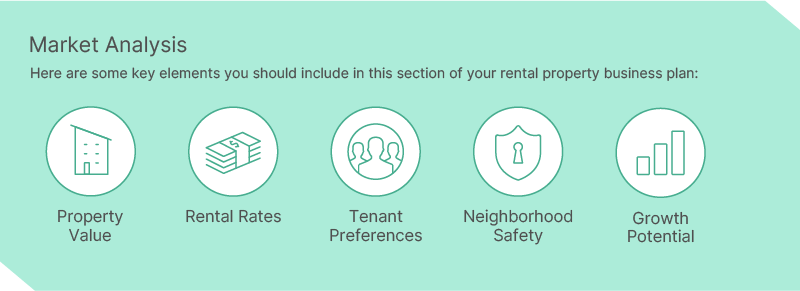
- Property Value: The value of a rental property is highly dependent on its location. By researching neighborhood trends, landlords can stay updated on changes in property values, both positive and negative. They can make informed decisions about whether to purchase, hold or sell their properties based on changes in the area.
- Rental Rates: Knowing the rental rates in a neighborhood can help landlords determine how much to charge for rent. Understanding how much other landlords charge for similar properties in the area can help a landlord price their property competitively and attract quality tenants.
- Tenant Preferences: Different neighborhoods appeal to different types of tenants. For example, families with children may prefer neighborhoods with good schools and parks, while young professionals may prefer areas with trendy restaurants and nightlife. By understanding neighborhood trends, landlords can cater to the preferences of their target tenants.
- Neighborhood Safety: Safety is a significant concern for tenants, and landlords can be held liable for any harm that befalls their tenants due to unsafe conditions on the property. Competitive landscape: There are several steps that landlords can take to research the competitive landscape of a rental market. These include identifying competitors, analyzing rental rates, researching amenities offered by competitors, and checking their online reviews.
- Growth potential: Consider external factors that may affect the rental market, such as population growth, job growth, or changes in zoning laws. This can help landlords identify potential growth opportunities in the market.
Marketing strategy
The marketing strategy section of your rental property business plan outlines how you will promote and advertise your rental properties to potential tenants. Below are some key elements to include in this section.
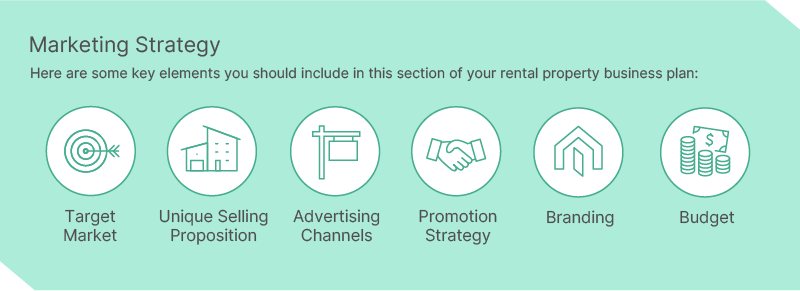
- Target Market: Identify the target market for rental properties, such as young professionals, families, or retirees. Describe their demographics, interests, and needs, and explain how the rental properties cater to these groups.
- Unique Selling Proposition: Identify the unique selling proposition of the rental properties, such as location, amenities, or affordability. Explain how these factors differentiate the properties from competitors in the market.
- Advertising Channels: Describe the advertising channels you'll use to promote the rental properties, such as online rental listings, social media, or local newspapers. Explain how you'll use these channels to reach the target market.
- Promotion Strategy: Describe the promotion strategy to attract tenants to the rental properties, such as discounts, referral bonuses, or move-in incentives. Explain how you'll communicate promotions to potential tenants and how they will be tracked and measured for effectiveness.
- Branding: Develop a branding strategy for the rental properties, including a logo, website, and promotional materials. Explain how the branding will reflect the unique selling proposition of the properties and how it will be used consistently across all marketing channels.
- Budget: Develop a marketing budget outlining each advertising channel's expected costs and promotion strategy. Explain how you'll track and adjust the budget as needed to ensure maximum return on investment.
Tenant screening
This section should outline the steps you or your property manager will take to evaluate potential tenants and ensure they fit your rental property well. This can ensure that your company has a thorough and fair process for evaluating potential tenants and selecting the best fit for their rental property. Below are some critical components to include in this section.
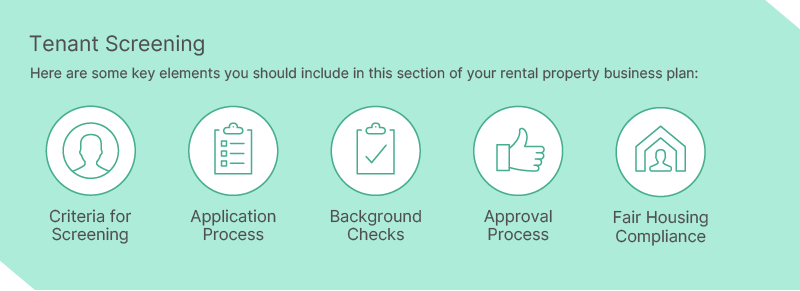
- Criteria for Screening: Define the criteria you will use to evaluate potential tenants. This includes credit score, income, employment, criminal, and rental history.
- Application Process: Detail the application process that potential tenants will go through. This may include the application form, application fee, and required documentation such as pay stubs, rental history, and references.
- Background Checks: Describe the background checks you'll conduct on potential tenants. This may include a credit check, criminal background check, and reference checks with previous landlords.
- Approval Process: Outline the process for approving or denying a tenant application. This may include a review of the applicant's qualifications, background check results, and a decision based on the landlord's discretion.
- Fair Housing Compliance: Include a statement about compliance with fair housing laws. Landlords and property managers must ensure they do not discriminate against applicants based on protected classes such as race, color, religion, sex, national origin, disability, or familial status.
Property Management
This section should outline the steps you or the property manager you have hired will take to manage the rental property effectively and ensure a positive experience for tenants. Below are some key components to include in the property management section of a rental property business plan.
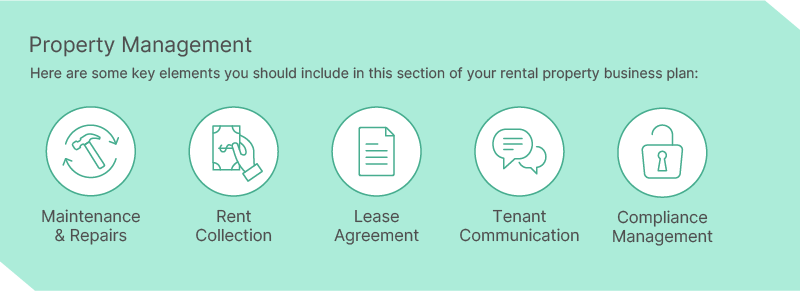
- Maintenance and Repairs: Outline the process for addressing maintenance and repair issues. This may include a description of how tenants can report problems, the timeline for responding to requests, and the types of repairs that are the landlord's responsibility versus the tenant's responsibility.
- Rent Collection: Detail the process for collecting rent from tenants. This may include the due date for rent payments, late fees, and consequences for non-payment.
- Lease Agreement: Describe the lease agreement that tenants will sign. This may include the length of the lease, rent amount, security deposit, and rules and regulations for the property.
- Tenant Communications: Outline your approach to communicating with tenants. This may include regular newsletters or updates on property maintenance, a process for addressing tenant concerns, and emergency contact information.
- Compliance and Risk Management: Include a statement about compliance with regulations and risk management. This may include descriptions of insurance coverage, safety protocols, and any regulatory requirements the business must follow.
Financials
The financials section of your rental property business plan is crucial for demonstrating the business's financial feasibility and potential profitability of the investment. Let's take a look at what you can include.
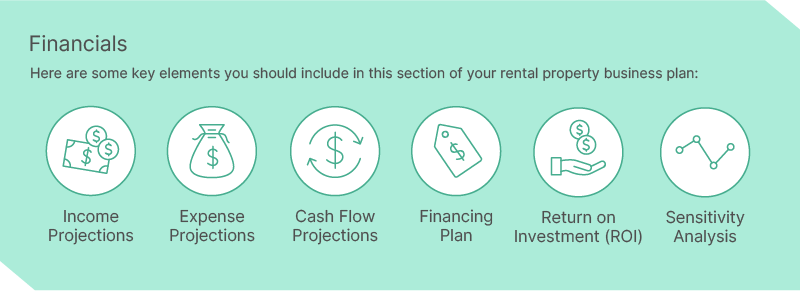
-
- Income projections: Start by estimating the expected rental income from the property. This should be based on market rates for similar properties in the area, considering location, size, amenities, and condition. Consider any potential income streams beyond rent, such as laundry facilities or parking fees.
- Expense projections: Next, estimate the ongoing expenses associated with owning and managing the property, including mortgage payments, property taxes, insurance, utilities, maintenance and repairs, and property management fees, if applicable. Be sure to factor in seasonal or irregular expenses, such as snow removal or landscaping.
- Cash flow projections: Based on the income and expense projections, calculate the expected net cash flow for the property monthly and annually. This will give you a sense of how much income the property will likely generate after paying expenses.
- Financing plan: If you plan to finance the purchase of the property, outline your financing plan, including the loan amount, interest rate, and repayment terms. Be sure to calculate the impact of financing on your cash flow projections.
- Return on investment: Calculate the property's expected ROI based on the initial investment and projected cash flows over a specified time (e.g., five years). This will give you a sense of whether the investment will likely be profitable in the long term.
- Sensitivity analysis: Conduct sensitivity analysis to assess the potential impact of changes in key assumptions (e.g., vacancy rate, rental income, expenses) on your cash flow projections and ROI. This will help you identify potential risks and make informed decisions about the investment.
Risk Management
As a landlord, you must include a risk management section in your rental property business plan to address potential risks and establish strategies for mitigating them. Below are some key steps you can take to create a risk management section for your business plan.
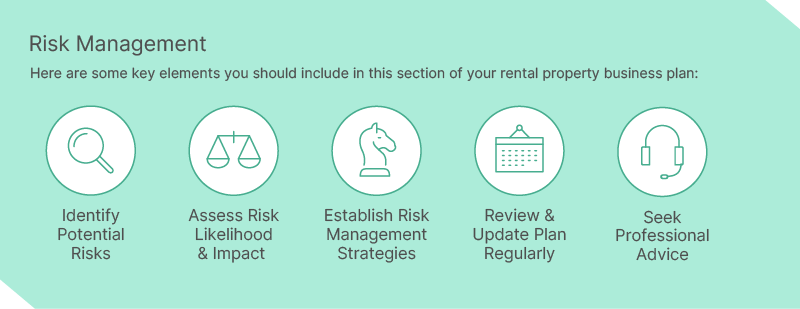
-
- Identify potential risks: Identify risks associated with your rental property business. This may include risks related to property damage, tenant safety, liability, financial loss, and legal compliance.
- Assess the likelihood and impact of each risk: Once you have identified potential risks, assess the likelihood and potential impact of each risk on your rental property business. This will help you prioritize which risks to address first and determine the resources you must allocate to manage each risk.
- Establish risk management strategies: Develop a plan for managing each identified risk. This may include measures to prevent the risk from occurring, as well as steps to mitigate the impact of the risk if it does happen. For example, you may establish a routine property inspection program to identify and address maintenance issues before they become significant problems. You may also require tenants to carry renters' insurance to mitigate financial loss if they cause damage to the property.
- Review and update your risk management plan regularly: Risks can change over time, so it's essential to review and update your plan regularly. This will help you ensure that your strategies are still effective and that you are prepared to manage new risks as they arise.
- Seek professional advice: Consider seeking professional advice from a lawyer, insurance agent, or another expert to help you identify potential risks and develop effective risk management strategies. This can help you ensure your business is well-protected and minimize risk exposure.
By including a comprehensive risk management section in your rental property business plan, you can demonstrate to potential investors, lenders, and tenants that you are committed to running a safe and sustainable rental property business.
Exit strategy
An exit strategy is integral to any rental property business plan as it helps you plan for the future and maximize your ROI. You most likely plan on renting out your property for a long or indefinite time. If you have a shorter or more definite timeline, like renting it out for ten years and then selling it, mention it here.
Should your property go vacant for a long time, or economic circumstances, cause rent prices to fall dramatically, maintaining your property may no longer be sustainable. You should have a plan, or at least a framework, to decide what to do if this happens. Otherwise, your exit strategy should be your backup plan if things don't go as planned.
Final thoughts
Creating a comprehensive rental property business plan provides you with a clear direction for your business, helps secure financing, identifies potential risks, enhances property management, and enables monitoring and evaluation of performance. A business plan is valuable for landlords who want to run a successful rental property business.